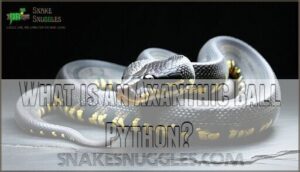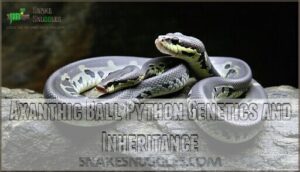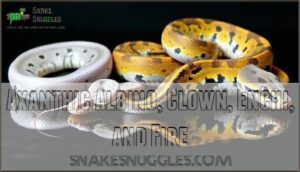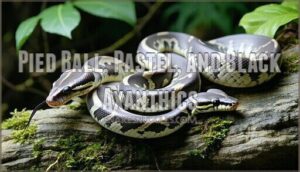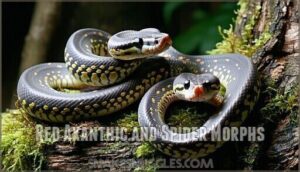This site is supported by our readers. We may earn a commission, at no cost to you, if you purchase through links.
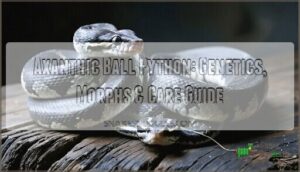
That’s when I learned about axanthic ball pythons, an alluring morph caused by a recessive gene that blocks yellow and red pigments entirely. These monochrome beauties start life with crisp contrast that can shift as they mature, and their genetics open fascinating possibilities for breeders who understand how recessive traits work.
Whether you’re drawn to their striking appearance or curious about the science behind color mutations, axanthic ball pythons represent one of the most visually distinct morphs in the hobby.
Table Of Contents
- Key Takeaways
- Axanthic Ball Python Overview
- What is an Axanthic Ball Python?
- Axanthic Ball Python Genetics and Inheritance
- Popular Axanthic Ball Python Combinations and Morphs
- Caring for an Axanthic Ball Python
- Axanthic Ball Python Health Concerns and Care
- Owning an Axanthic Ball Python: Legality and Considerations
- Frequently Asked Questions (FAQs)
- What is an axanthic ball python?
- What is the most sought after ball python morph?
- What is axanthic?
- What does het axanthic mean?
- How to breed incompatible axanthic lines successfully?
- What are common misconceptions about axanthic ball pythons?
- How does axanthism impact python behavior?
- Are there axanthic morphs in other species?
- What are ethical considerations for breeding axanthics?
- How much does an axanthic ball python cost?
- Conclusion
Key Takeaways
- Axanthic ball pythons display a striking grayscale appearance caused by a recessive gene that completely blocks yellow and red pigments, though roughly 90% develop brownish tones ("brown out") during their first three years as they mature.
- Four distinct genetic bloodlines exist (VPI, TSK, Jolliff, and MJ) that are incompatible with each other—crossing different lines produces only normal-looking offspring, making lineage verification essential for successful breeding programs.
- These morphs require the same care as standard ball pythons (88-90°F basking spot, 50-60% humidity, appropriately-sized frozen rodents), with prices ranging from $125 for basic axanthics to over $4,500 for complex designer combinations like Snow Balls or multi-gene morphs.
- Responsible ownership demands understanding both the 30-year lifespan commitment and varying legal restrictions, as some states like Hawaii ban ball pythons entirely while others require permits or registration.
Axanthic Ball Python Overview
If you’re curious about axanthic ball pythons, you’re in for a treat. These striking snakes stand out from typical ball pythons with their monochrome color palette—think black, white, and gray instead of the usual warm yellows and oranges.
Let’s explore what makes these pythons unique, from their fascinating genetic backstory to the different bloodlines and morphs you’ll encounter in the breeding world.
Appearance and Genetics
When you picture a ball python stripped of its warm yellows and fiery oranges, you’re looking at the axanthic morph—a snake that wears its recessive genetics like a black-and-white photograph come to life. This pigment absence creates a stunning grayscale palette that shifts with age, though color development varies between genetic lines.
The axanthic ball python morph appearance depends on these recessive traits:
- Baby axanthics display crisp blacks, whites, and silvers
- Adult morphs often brown out as they mature
- Different genetic lines retain varying degrees of contrast
Understanding axanthic genes helps you predict morph variations in your breeding projects.
History and Origins
Your axanthic ball python’s story started in 1997, when VPI (Vida Preciosa International) successfully bred the first axanthic morph, not 1991 as some sources claim. This VPI’s Discovery marked a major advance in understanding recessive genetic mutation in ball pythons.
Early breeding revealed something unexpected—different axanthic ball python lines like VPI Axanthics and TSK Axanthics couldn’t produce axanthic offspring together, exposing lineage incompatibilities. The lack of yellow color is due to the axanthic genetic mutation.
This discovery transformed morph development, showing breeders that axanthic genes weren’t all created equal.
Bloodlines and Morphs
You’ll find at least four major Axanthic ball python lines—VPI, TSK, Jolliff, and MJ—each carrying unique mutations that make lineage incompatibilities a real concern. When you cross different lines, you’ll get normal-looking offspring, confirming these are independent mutations. That’s why genetic verification through pedigree records matters so much to breeders.
Designer morphs like Snow (axanthic + albino) and Pastel Axanthic showcase how axanthic genes create stunning axanthic combinations, with color retention varying by bloodline.
These axanthic ball python genetics drive impressive market value—basic morphs start around $125, while complex combinations reach $4,500. Understanding heterozygous gene carriers is key to predicting offspring traits.
What is an Axanthic Ball Python?
If you’ve ever wondered what makes an axanthic ball python stand out from the crowd, you’re in the right place. These snakes aren’t your typical colorful morphs—they’re more like living black-and-white photographs.
Let’s break down what defines this unique morph and what makes it so special to breeders and keepers alike.
Definition and Characteristics
You might think these snakes look like black-and-white photographs come to life. An axanthic ball python is a color mutation of the species Python regius, defined by a recessive genetic trait that prevents production of yellow and red pigments in their skin. This pigment absence creates a striking grayscale appearance, with shades ranging from deep charcoal to silvery white.
When you compare them to standard ball pythons, you’ll notice pattern reduction, meaning their markings appear more subtle and uniform. The axanthic morph retains the classic ball python puzzle pattern, but without those warm golden tones.
Identifying axanthic ball pythons is straightforward once you know what to look for: their unique features include a monochromatic palette with occasional brownish tones developing as they mature, especially in adults.
Grayscale Appearance and Pattern
When you first lay eyes on an axanthic ball python, it’s like watching a storm cloud take the shape of a serpent—soft grays bleeding into deep blacks with an almost metallic sheen under the right light. Their patterns showcase striking pattern reduction compared to wild-type ball pythons, creating cleaner, more defined borders between scales.
An axanthic ball python looks like a storm cloud shaped into a serpent, with soft grays bleeding into deep blacks and an almost metallic sheen under the right light
Here’s what makes their grayscale appearance truly alluring:
- Juvenile coloration starts as pure black and white contrast
- Adults develop umber background tones through natural color changes
- Different bloodlines retain varying degrees of silver brilliance
- Morph variations intensify or soften the grayscale palette
- Each axanthic individual displays unique coloration intensity
These axanthic ball python specimens maintain their signature patterns throughout life, though maturity brings subtle transformations.
Lack of Yellow Pigment and Unique Features
The real magic behind an axanthic ball python’s striking appearance isn’t what you see—it’s what’s missing at the cellular level. These snakes lack yellow pigment entirely because their xanthophores don’t produce the usual golden hues, leaving behind only melanin production for coloring.
This creates their distinctive grayscale appearance and monochromatic pattern reduction. While juveniles display stark black-and-white contrast, visual variations emerge as adults develop an umber background through natural color changes, giving each axanthic ball python its unique appearance.
Axanthic Ball Python Genetics and Inheritance
Understanding axanthic genetics is key to successfully breeding these stunning morphs. The axanthic gene works differently than you might expect, with recessive inheritance creating some interesting breeding challenges.
Let’s look at how this gene passes from parents to offspring and why bloodline compatibility matters so much.
Pattern of Inheritance and Recessive Gene
Axanthic ball python genetics follow a straightforward recessive inheritance pattern, meaning your snake needs two copies of the mutant gene to display that striking grayscale look. Homozygous axanthics show complete penetrance—they always express the phenotype—while heterozygous carriers look identical to wild-type pythons.
If you breed two het (heterozygous) axanthics, expect about 25% visual axanthics, 50% hets, and 25% normals per clutch.
The culprit behind this recessive genetic trait is a premature stop codon in the GCH2 gene, which blocks yellow pigment production entirely.
Incompatible Lines and Breeding Complications
Breeding axanthic ball pythons isn’t as simple as pairing any two axanthics—line incompatibility can derail your entire project. Different Axanthic ball python genetic lineages (VPI, TSK, Jolliff, MJ) carry distinct genetic markers that won’t interact to produce visual axanthics when crossed.
Here’s what you need to know about Axanthic ball python breeding:
- Breeding Strategies: Always verify your snake’s specific lineage before pairing to avoid wasted clutches.
- Line Incompatibility: Crossing a VPI axanthic with a TSK axanthic produces normal-looking offspring carrying incompatible het genes.
- Genetic Markers: Each line represents a separate mutation affecting yellow pigment production differently.
- Ethical Considerations: Transparent disclosure of your snake’s line protects buyers from future breeding complications and maintains integrity in Axanthic morph breeding.
Stick with one proven Ball python genetic lineage for consistent results and avoid the heartbreak of normal-looking babies from two "axanthic" parents.
Homozygous and Heterozygous Axanthic Pythons
Understanding homozygous versus heterozygous genetics is like learning the difference between a visual axanthic and a hidden carrier—one shows you exactly what it is, while the other keeps its secrets tucked away in its DNA. Homozygous Axanthics carry two copies of the recessive genes, displaying that striking grayscale appearance you’re after. Heterozygous Carriers (het Axanthic) look completely normal but carry one hidden axanthic gene.
Breeding Outcomes depend entirely on your pairings—two hets produce 25% visual Axanthic ball pythons, while homozygous paired with het yields 50% visuals. Genetic Testing confirms carriers when Visual Identification fails, protecting your breeding program from guesswork.
| Genotype | Appearance | Breeding Value |
|---|---|---|
| Homozygous (AA) | Visual grayscale axanthic | Produces 100% het offspring with normals |
| Heterozygous (Aa) | Normal-looking carrier | 25% visual axanthics when paired together |
| Normal (aa) | Standard ball python coloring | No axanthic genetics present |
Popular Axanthic Ball Python Combinations and Morphs
Once you understand the basics of axanthic genetics, you can start exploring the exciting world of designer morphs. Breeders combine the axanthic gene with other mutations to create stunning variations that push the boundaries of what’s possible.
Let’s look at some of the most popular axanthic combinations you’ll find in today’s market.
Axanthic Albino, Clown, Enchi, and Fire
When you combine Axanthic with other recessive or incomplete dominant genes, you’re opening the door to some truly breathtaking designer morphs. Snow Ball genetics—pairing Axanthic with Albino—produce nearly pure white snakes with pink eyes, a result of eliminating both yellow and dark pigments.
Here are four combinations that showcase what’s possible:
- Axanthic Albino (Snow Ball): Almost entirely white with pink eyes, priced from $250 to over $4,500 depending on additional genes
- Axanthic Clown: Grayscale patterns with unique "alien head" markings, thanks to distinct Clown morph alleles on chromosome three
- Axanthic Enchi: Copper and bronze highlights emerge within the grayscale, a surprising twist from Enchi pattern origins in Ghana
- Axanthic Fire: Fire gene effects create sharper contrast and cleaner whites, making these snakes ideal for complex projects
Combo market trends show strong demand, with multi-gene morphs fetching premium prices.
Pied Ball, Pastel, and Black Axanthics
If you’re ready to step beyond basic designer combos, Pied, Pastel, and Black Axanthics are where things get seriously eye-catching. Axanthic Piebald snakes pair unpigmented white patches with grayscale patterns, creating dramatic contrast that’s tough to beat.
Axanthic Pastel morphs brighten the typical gray tones, adding a silvery shimmer that improves overall appearance. Black Axanthic genetics push melanin production to the max, delivering deep charcoal hues with crisp whites.
Breeding considerations matter here—you’ll need compatible Axanthic lines and careful gene pairing. These ball python morphs command strong market value, with Pied Axanthic traits fetching premium prices due to their striking visual appeal.
Red Axanthic and Spider Morphs
When you’re hunting for that superior designer morph, Red Axanthic and Spider combinations deliver the kind of pattern disruption that turns heads at any reptile show. Red Axanthic genetics improve grayscale tones with subtle bronze undertones, while Axanthic Spider morphs showcase wild pattern reduction—though you’ll need to assess Spider morph wobble carefully. These Axanthic ball python combinations require responsible breeding practices:
- Pattern Impact: Axanthic Fire Spider combos create striking, high-contrast appearances
- Health Considerations: Spider health issues demand honest evaluation before breeding
- Market Appeal: Red Spider breeding projects command attention but prioritize animal welfare
Caring for an Axanthic Ball Python
Caring for an axanthic ball python isn’t complicated, but you’ll need to get a few key things right from the start. These snakes thrive when their enclosure mimics their natural environment, with proper heating, humidity, and space to move around.
Let’s break down what you need to set up a comfortable home for your grayscale beauty.
Enclosure Size and Temperature Requirements
Once you’ve nailed the enclosure size, dialing in the right temperature gradient becomes your next priority for keeping your axanthic healthy and stress-free. Think of your snake enclosure as having different climate zones.
You’ll need a basking spot that reaches around 88-90°F on one end, while the cool side sits at 75-80°F. This temperature gradient lets your snake regulate its body heat naturally, moving between zones as needed.
Use an under-tank heater or heat lamp with a thermostat to maintain consistent warmth. Tank size matters here because a 40-gallon vivarium or larger gives you enough space to create these distinct temperature zones. Always monitor both ends with reliable thermometers to prevent overheating or dangerous temperature drops.
Humidity, Substrate, and Hiding Places
After you’ve sorted temperature, the next piece of the puzzle is getting humidity and substrate right—both work hand-in-hand to keep your axanthic comfortable and shedding smoothly. You’ll want to maintain humidity levels between 50-60%, which helps prevent stuck sheds and respiratory issues.
Here’s what you need to create the ideal snake habitat:
- Choose moisture-retaining substrate types like coconut husk or cypress mulch that hold humidity without getting soggy
- Monitor humidity control with a reliable hygrometer, misting when levels drop below 50%
- Prevent mold by spot-cleaning waste immediately and replacing damp substrate regularly
- Provide at least two hiding spots—one on the warm side, one on the cool—so your python feels secure throughout its enclosure
Getting these environmental needs dialed in makes shedding success almost automatic.
Feeding Schedule and Prey Items
Getting your axanthic’s feeding routine dialed in means matching prey size to your snake’s age and body condition. Hatchlings thrive on appropriately-sized mice every 5-7 days, while adults graduate to rats on a less frequent schedule. Stick with frozen rodents rather than live prey, which can bite and injure your python during feeding. The general rule? Your prey size should match the widest part of your snake’s body—no bigger.
Adults usually eat every 10-14 days, though some mature snakes do fine on a three-week rotation. If your axanthic refuses food, don’t panic—stress from interaction, shedding cycles, or seasonal changes often trigger temporary fasting.
Supplementation needs are minimal with whole prey items since they provide complete nutrition.
Axanthic Ball Python Health Concerns and Care
Even with solid care, your axanthic ball python can run into health issues that need your attention. Catching problems early makes all the difference in keeping your snake healthy for decades.
Let’s look at the most common concerns you’ll want to watch for and how to address them.
Improper Shedding and Feeding Issues
Shedding problems and picky eating habits are two of the most common roadblocks you’ll encounter with your axanthic ball python, but both are usually easy fixes once you know what to do. Incomplete shedding usually points to humidity issues—your snake needs 50-60% humidity to shed properly. Watch for retained eyecaps, which can cloud vision if left unchecked. Misting the enclosure and providing a humid hide can make a real difference.
For appetite loss, examine your prey size first—rodents should match your snake’s girth at its widest point. Feeding too large or too small disrupts their natural eating rhythm. Stress, inconsistent shedding frequency, and restraint too soon after meals can trigger regurgitation, which you’ll want to avoid.
Regular Health Check-Ups and Preventative Measures
Staying ahead of health issues means catching them early, and that’s where routine vet visits and smart preventative care come into play. Partner with a reptile-savvy veterinarian who understands axanthic ball python health and can spot snake health issues before they escalate. Regular checkups help you stay on top of potential problems and keep your snake thriving.
Here’s your preventative care checklist:
- Parasite prevention: Fecal exams catch internal parasites early, preventing serious complications
- Quarantine protocols: Isolate new snakes for 60-90 days to protect your existing collection
- Scale observation: Check regularly for mites, retained shed, or unusual discoloration
- Hydration importance: Fresh water daily prevents dehydration and promotes healthy shedding
- Shedding problems: Monitor shed cycles and adjust humidity to avoid incomplete sheds
Consistent care prevents most snake health concerns from developing.
Owning an Axanthic Ball Python: Legality and Considerations
Before you bring home an axanthic ball python, you’ll want to understand the legal landscape and what responsible ownership really means. Different states and cities have their own rules about keeping snakes, and this isn’t a pet you can commit to lightly.
Let’s walk through what you need to know before making this 30-year decision.
Laws and Regulations Regarding Exotic Pets
Before bringing an axanthic ball python home, you’ll need to navigate the legal landscape surrounding exotic pet ownership. At the federal level, ball pythons aren’t banned outright, though the Lacey Act restricts certain python species under Federal Restrictions.
State Permits vary widely—California demands strict permits for reptiles, while Texas allows ownership with simple registration. Hawaii takes the hardest line, banning ball pythons entirely with fines reaching $200,000. Don’t forget Local Bans either—over 200 U.S. municipalities enforce their own rules beyond state laws.
International Laws also matter if you’re importing, since CITES requires export permits for trade. Enforcement Measures are real, with documented home inspections and seizures across multiple states. Contact your local wildlife authorities or experienced ball python care experts to confirm you’re following the rules for responsible axanthic ownership.
Responsible Ownership and Long-Term Commitment
Committing to an axanthic ball python means signing up for a relationship that could span three decades—longer than most car loans and many marriages. Responsible axanthic ownership demands financial commitment for proper enclosures, heating, veterinary care, and consistent feeding. Ethical sourcing from reputable breeders prevents supporting questionable breeding practices.
You’ll need owner preparedness for axanthic ball python health considerations, including potential medical emergencies. Lifespan expectations require serious relinquishment planning—what happens if life changes?
Weighing axanthic ball python pros and cons before purchasing ensures ethical ownership and proper ball python care and maintenance throughout their remarkably long lives.
Researching and Preparing for Axanthic Ball Python Care
Before you bring home that stunning grayscale morph, you need to do your homework—because proper preparation separates thriving snakes from struggling ones. Initial research should cover axanthic ball python environmental needs, local exotic pet regulations, and long-term ball python care and maintenance requirements. Snake enclosure setup demands careful planning—you’ll need proper heating, humidity controls, and adequate space before your python arrives.
Here’s your preparation checklist:
- Financial commitment: Budget for the axanthic ball python price, enclosure setup costs, and ongoing expenses like frozen prey and veterinary care
- Time commitment: Plan for daily monitoring, weekly feeding, and routine maintenance throughout their 30-year lifespan
- Ethical sourcing: Research reputable breeders who maintain proper bloodline records and health documentation
Quality axanthic ball python care starts with thorough preparation, not impulse decisions.
Frequently Asked Questions (FAQs)
What is an axanthic ball python?
Picture a ball python stripped of warmth—no sunny yellows or fiery reds, just crisp grays, blacks, and whites. An axanthic ball python showcases this stunning color mutation caused by pigment absence in their scales.
This recessive gene creates grayscale pattern variations that make them stand out among ball python morphs, though their morph rarity reflects the genetics involved in breeding them.
What is the most sought after ball python morph?
The Pied Ball Python ranks among the most coveted ball python morphs, prized for its bold white patches that create a stunning contrast against darker colors.
This dramatic, unpredictable patterning drives high demand and premium axanthic ball python price points in the designer ball python morphs market.
What is axanthic?
In the reptile world, axanthic is like looking at a black-and-white photograph come to life. This color mutation results from pigment absence—specifically, yellow and red pigments are missing entirely.
You’ll see visual variations showcasing only blacks, grays, whites, and sometimes an umber background that creates that striking monochromatic appearance collectors love.
What does het axanthic mean?
Het axanthic" means heterozygous—your snake carries one copy of the recessive axanthic gene but won’t show it visually.
It looks like a normal ball python but can pass that hidden trait to offspring when bred with another het or visual axanthic.
How to breed incompatible axanthic lines successfully?
Here’s the thing—incompatible axanthic lines can’t produce visual axanthics together. Lineage research reveals different recessive genes at play.
Instead, focus your breeding program on outcrossing benefits within compatible lines, using genetic markers and selective breeding to boost hybrid vigor while working with recessive genes in ball pythons strategically.
What are common misconceptions about axanthic ball pythons?
Many people believe axanthic ball pythons stay purely gray forever, but most develop brownish tones as they mature—a process breeders call "browning out."
Another misconception is that all axanthics look identical, when different bloodlines actually produce distinct variations in pattern fading and color intensity.
How does axanthism impact python behavior?
Good news—the pigment shift doesn’t rewire your snake’s brain. Axanthic ball pythons maintain typical hunting strategies, stress responses, and activity levels just like standard morphs.
Their grayscale genetics affect appearance only, not learning ability or behavior patterns.
Are there axanthic morphs in other species?
Axanthism isn’t limited to ball pythons—it shows up across reptiles and amphibians like axolotls, bearded dragons, iguanas, and skinks.
This genetic mutation strips away yellow and red pigments, leaving striking grayscale color morphs. These make snake species and other creatures look dramatically different from their wild-type relatives.
What are ethical considerations for breeding axanthics?
When breeding ball pythons, you’re influencing the heredity of these animals. Ethical breeding practices prioritize genetic diversity over consumer demand, morph health, and long-term population viability.
Responsible breeding programs avoid excessive inbreeding, maintain detailed lineage records, and never compromise animal welfare for aesthetics alone.
How much does an axanthic ball python cost?
Pricing in the reptile market reflects morph rarity and breeder reputation. Basic Axanthic ball pythons start around $125, while designer combinations reach $1,500 or more.
Age influence and sex variations adjust these figures, making each Axanthic ball python an investment with unique pricing factors.
Conclusion
Here’s something striking: roughly 90% of axanthic ball pythons dramatically shift in appearance during their first three years, with some gaining brownish tones that blur their once-crisp black-and-white contrast.
Understanding these changes, along with bloodline compatibility and recessive genetics, sets you up for success whether you’re breeding your first axanthic ball python or simply keeping one as a fascinating companion.
Their monochrome beauty demands knowledge, but the reward is a snake that turns heads every time.
- https://petcorner.pangovet.com/pet-health-wellness/snakes/how-to-take-care-of-a-ball-python/
- https://reptilesmagazine.com/ball-python-morph-history/
- https://www.morphmarket.com/stores/vpi/
- https://www.worldofballpythons.com/morphs/axanthic/
- https://pangovet.com/pet-breeds/snakes/axanthic-ball-python-morph/

